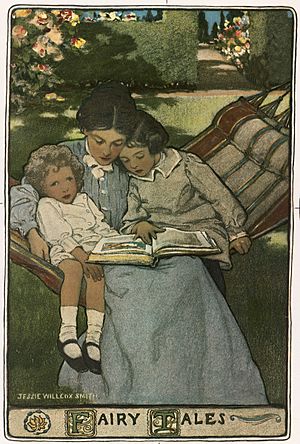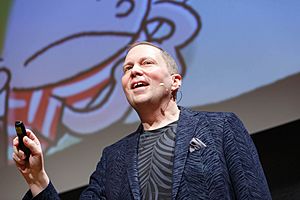Children's literature facts for kids

Children's literature refers to books written especially for kids and young people. Many famous authors have written amazing stories for children. Some of these include Beatrix Potter, who created Peter Rabbit, and Dr. Seuss, known for his rhyming books. Other well-known writers are A.A. Milne, J. M. Barrie (who wrote Peter Pan), Lewis Carroll (who wrote Alice in Wonderland), and fantasy authors like JRR Tolkien and C. S. Lewis. The Newbery Medal is a special award given to authors for the best children's books each year.
Contents
What is Children's Literature?
Children's literature is a wide world of books made for young readers. These books are often grouped in different ways, usually by their style (called genre) or by the age of the kids they are meant for. For example, young-adult fiction is a type of literature written for teenagers, usually between 12 and 18 years old.
Different Types of Books (Genres)
A literary genre is like a category for books based on their style, what they are about, or how they are written. Here are some common genres in children's literature:
- Picture books: These books use lots of pictures to tell a story, often with very few words or sometimes no words at all. They are great for teaching young children things like the alphabet or counting.
- Traditional literature: This includes old stories passed down through generations. They share the customs, beliefs, and legends of people from long ago. This group has different types:
- Myths: Ancient stories, often about gods or heroes, explaining how the world began or why things are the way they are.
- Fables: Short stories, often with animals as characters, that teach a moral lesson.
- Legends: Stories about heroes or events from the past that are often based on some truth but have been exaggerated over time.
- Fairy tales: Magical stories with imaginary creatures, often teaching lessons about good and evil.
- Fiction: These are made-up stories. They can be:
- Fantasy: Stories set in imaginary worlds with magic and mythical creatures.
- Realistic fiction: Stories that could happen in real life, with characters and events that seem real.
- Historical fiction: Stories set in the past, often mixing real historical events with made-up characters.
- Non-fiction: Books that give true information about real topics, people, or events.
- Biography and autobiography: A biography is a true story about someone's life written by another person. An autobiography is a true story about someone's life written by that person themselves.
- Poetry: Books written in verse, focusing on rhythm, rhyme, and expressive language.
Many children's books also aim to teach important lessons. For example, some stories show what can happen if characters behave badly, like running away or telling lies. Tom Sawyer and Toby Tyler are classic examples of stories that teach lessons through their characters' adventures.
Famous Authors and Books

Children's literature has given us many beloved characters and stories. Authors like Dav Pilkey, known for his funny Captain Underpants series, have captured the imaginations of millions of young readers. Other famous names include J. K. Rowling, who wrote the Harry Potter books, and Roald Dahl, famous for Charlie and the Chocolate Factory and many other imaginative tales.
There are many classic books that children have enjoyed for generations. These include The Adventures of Pinocchio, Peter Pan, and Treasure Island. Comics like The Beano, featuring characters like Minnie the Minx and Dennis the Menace, have also been popular for their humorous stories.
Images for kids
-
The Adventures of Pinocchio (1883) is a canonical piece of children's literature and one of the best-selling books ever published.
-
Newbery's A Little Pretty Pocket-Book, originally published in 1744
-
A woodcut of the eponymous Goody Two-Shoes from the 1768 edition of The History of Little Goody Two-Shoes. It was first published in London in 1765.
-
Pages from the 1819 edition of Kinder- und Haus-Märchen by the Brothers Grimm
-
Peter Pan statue in Kensington Gardens, London
-
Statue of C. S. Lewis in front of the wardrobe from his Narnia book The Lion, the Witch and the Wardrobe
-
Willy Wonka (from Roald Dahl's Charlie and the Chocolate Factory), and the Mad Hatter (from Lewis Carroll's Alice's Adventures in Wonderland) in London
-
J. K. Rowling reads from her novel Harry Potter and the Philosopher's Stone
-
Illustration from Robert Louis Stevenson's 1883 pirate adventure Treasure Island
-
Statue of Minnie the Minx, a character from The Beano. Launched in 1938, the comic is known for its anarchic humour, with Dennis the Menace appearing on the cover.
-
The Story of Mankind (1921) by Hendrik van Loon, 1st Newbery Award winner
-
The Crescent Moon by Rabindranath Tagore illus. by Nandalal Bose, Macmillan 1913
-
A Tagore illustration of a Hindu myth
-
A late 18th-century reprint of Orbis Pictus by Comenius, the first children's picture book.
-
1900 edition of the controversial The Story of Little Black Sambo
See also
 In Spanish: Literatura infantil para niños
In Spanish: Literatura infantil para niños


















